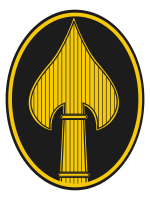Office of Strategic Services

OSS insignia
|
|
| Agency overview | |
|---|---|
| Formed | June 13, 1942 |
| Preceding agency | |
| Dissolved | September 20, 1945 |
| Superseding agency | |
| Employees | 13,000 estimated |
| Agency executives |
|
The Office of Strategic Services (OSS) was a wartime intelligence agency of the United States during World War II, and a predecessor of the modern Central Intelligence Agency (CIA). The OSS was formed as an agency of the Joint Chiefs of Staff (JCS) to coordinate espionage activities behind enemy lines for all branches of the United States Armed Forces. Other OSS functions included the use of propaganda, subversion, and post-war planning.
Prior to the formation of the OSS, American intelligence had been conducted on an ad-hoc basis by the various departments of the executive branch, including the State, Treasury, Navy, and War Departments. It had no overall direction, coordination, or control. The US Army and US Navy had separate code-breaking departments: Signal Intelligence Service and OP-20-G. (A previous code-breaking operation of the State Department, the MI-8, run by Herbert Yardley, had been shut down in 1929 by Secretary of State Henry Stimson, deeming it an inappropriate function for the diplomatic arm, because "gentlemen don't read each other's mail".) The FBI was responsible for domestic security and anti-espionage operations.
President Franklin D. Roosevelt was concerned about American intelligence deficiencies. On the suggestion of William Stephenson, the senior British intelligence officer in the western hemisphere, Roosevelt requested that William J. Donovan draft a plan for an intelligence service based on the British Secret Intelligence Service (MI6) and Special Operations Executive (SOE). Colonel Donovan was employed to evaluate the global military position to offer suggestions concerning American intelligence requirements because the U.S. did not have a central intelligence agency. After submitting his work, "Memorandum of Establishment of Service of Strategic Information," Colonel Donovan was appointed "coordinator of information" on July 11, 1941 heading the new organization known as the office of the Coordinator of Information (COI). Thereafter the organization was developed with British assistance; Donovan had responsibilities but no actual powers and the existing US agencies were skeptical if not hostile. Until some months after Pearl Harbor, the bulk of OSS intelligence came from the UK. British Security Coordination (BSC) trained the first OSS agents in Canada, until training stations were set up in the US with guidance from BSC instructors, who also provided information on how the SOE was arranged and managed. The British immediately made available their short-wave broadcasting capabilities to Europe, Africa, and the Far East and provided equipment for agents until American production was established.
...
Wikipedia
